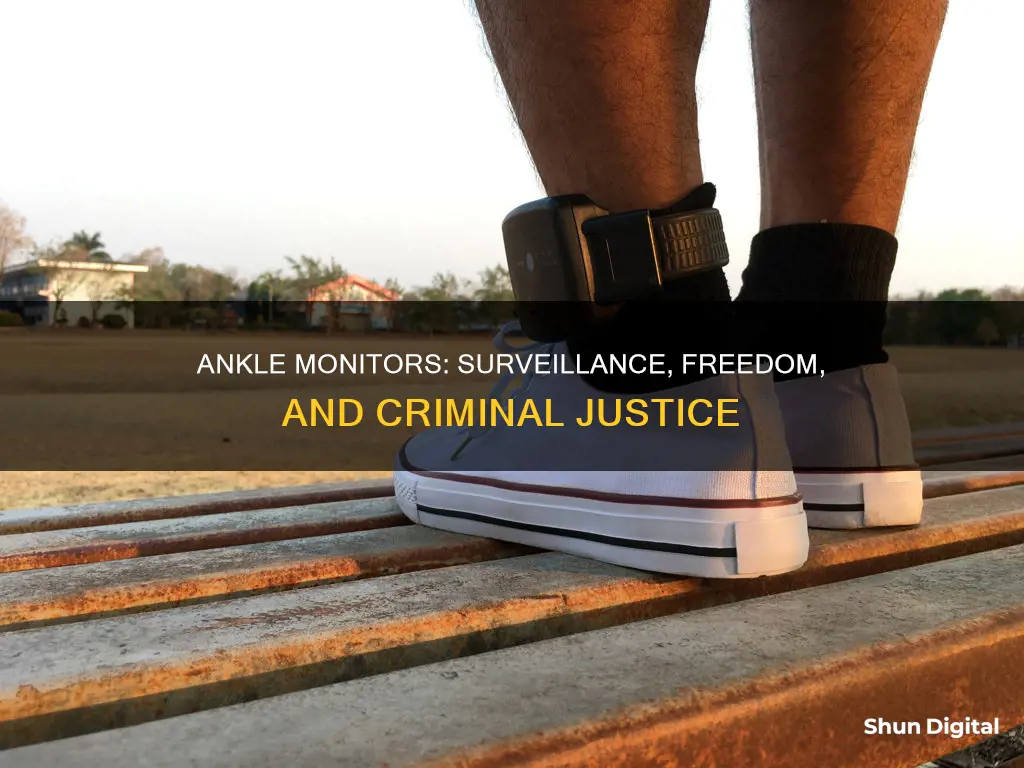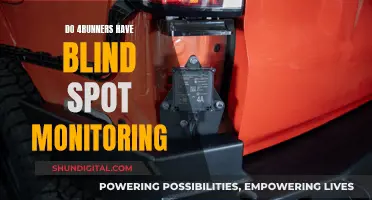
Ankle monitors are typically used as an alternative to incarceration, allowing authorities to track an individual's location and ensure they don't get into more trouble. They are often used for people awaiting trial, serving probation or parole, or facing immigration proceedings. Ankle monitors can also be used to enforce house arrest, prevent domestic violence offenders from approaching their victims, and monitor alcohol consumption for those convicted of DUI or other alcohol-related crimes. The use of ankle monitors has been controversial, with critics arguing that they fail to meet their stated goals, expand mass incarceration, and exacerbate systemic inequities.
What You'll Learn

As an alternative to incarceration
Ankle monitors are often used as an alternative to incarceration for individuals who are on probation, parole, or house arrest, or for those who are awaiting trial. They are typically worn by people who have been convicted of a crime but are considered low-risk and not a danger to the community. During the COVID-19 pandemic, ankle monitors were also used as an alternative to bail for those awaiting trial, as prisons became overcrowded and disease hotspots.
Ankle monitors are seen as a way to keep individuals connected to their communities and allow them to maintain their jobs and support their families while serving their sentences. They are also a less expensive option than traditional imprisonment, both for the state and, in some cases, the individual. In some jurisdictions, the cost of the ankle monitor is passed on to the person wearing it, which can amount to hundreds of dollars per month.
However, ankle monitors have been criticised for their negative impact on the lives of those who wear them. People with ankle monitors often face strict rules and regulations, with any violation resulting in additional penalties or even imprisonment. The nature and number of these rules can be vague and overly broad, and set people up for failure and re-incarceration. For example, failure to charge the device or leaving the house without permission can result in a return to prison.
Ankle monitors also raise concerns about privacy rights, as they capture and store large amounts of location and movement data, which is often shared with law enforcement agencies and the courts. This data can also affect the privacy of family and friends through invasive home searches. Furthermore, critics argue that ankle monitors do not address the systemic issues that lead to incarceration, such as unemployment, poverty, and structural racism.
A Clean Screen: Removing Fingerprints from Your Monitor
You may want to see also

To keep track of someone until they go to trial
Ankle monitors are often used as a way to keep track of someone until they go to trial. This is usually the case when the court considers the individual a flight risk or a danger to the community. By wearing an ankle monitor, the court can ensure that the individual stays within the boundaries set by the court and does not get into more trouble.
Ankle monitors with GPS tracking technology are used to monitor the location of the wearer 24 hours a day. The GPS technology uses radio frequency signals to communicate the wearer's location to a monitoring station. If the wearer goes outside a specific perimeter, the monitor will alert the monitoring station, and they may face consequences such as jail time.
In addition to location tracking, ankle monitors may also be used to monitor other activities, such as alcohol consumption. For example, a Secure Continuous Remote Alcohol Monitoring (SCRAM) bracelet can detect alcohol levels by testing the wearer's sweat and relaying this information to the relevant authorities. This is often used for individuals with DUI or DWI convictions to ensure they comply with court orders not to drink.
The use of ankle monitors as a form of pre-trial monitoring has been controversial. Some argue that it is a less restrictive alternative to incarceration, especially in light of the COVID-19 pandemic, as it allows individuals to remain out of crowded jails and prisons. However, critics argue that ankle monitors fail to meet their stated goals of ensuring court appearances, protecting public safety, and advancing rehabilitation. Instead, they contribute to mass incarceration, leading people back to jail or prison for minor technical violations, charging malfunctions, and false alarms.
Furthermore, the use of ankle monitors has been shown to exacerbate systemic inequities, with people of colour being more likely to be electronically monitored. The financial burden of wearing an ankle monitor, which includes setup charges and daily fees, can also be significant, creating additional challenges for individuals and their families.
Governments' Internet Surveillance: Privacy and Security Concerns
You may want to see also

To ensure someone under house arrest doesn't leave their home
Ankle monitors are often used as a way to ensure that someone under house arrest doesn't leave their home. They are used as an alternative to incarceration, allowing people to remain in their community and maintain their family and community ties. During the COVID-19 pandemic, ankle monitors were used to facilitate the release of incarcerated people as prisons became coronavirus hotspots.
Ankle monitors are typically used for people who are on house arrest, probation, or parole. They are also used for people awaiting trial, particularly if there is a risk of them fleeing. In some cases, ankle monitors are used as a condition of probation, allowing people to shorten their jail sentence or avoid incarceration altogether.
Ankle monitors use GPS technology to track the wearer's location, and this data is monitored 24 hours a day. The monitor will alert the monitoring station if the wearer goes outside a specific perimeter. This allows probation or parole officers to monitor the wearer's whereabouts and ensure compliance with the conditions of house arrest.
The use of ankle monitors has been criticized by some, who argue that they do not help people get their lives back on track after prison and that there is no evidence that they are rehabilitative. Additionally, the cost of the monitors is often passed on to the wearer, which can be a significant financial burden.
Setting Up Studio Monitors: Interface Connection Guide
You may want to see also

To monitor alcohol consumption
Ankle monitors are often used to monitor alcohol consumption, especially in the case of hardcore drunk drivers, high-risk alcoholics, and domestic violence offenders. These monitors are known as Secure Continuous Remote Alcohol Monitors, or SCRAM for short. They are also known as Continuous Alcohol Monitoring bracelets, or CAM.
SCRAM bracelets are court-ordered and worn on the ankle to monitor an individual's blood alcohol concentration. They are often used as a penalty for DUI offenders, especially those who are second- or third-time offenders. The bracelets can also be used as a pretrial condition of probation that determines someone’s release from jail.
The SCRAM bracelet tests the wearer's perspiration or sweat every 30 minutes, 24 hours a day, to detect the presence of alcohol. This is known as transdermal alcohol testing or transdermal alcohol concentration. The science behind this is that while 95% of alcohol is metabolized by the liver, 4% is expelled through the lungs and kidneys, and the remaining 1% is eliminated through the skin via sweat.
If the SCRAM bracelet detects alcohol consumption, an alert is sent to a database, and a trained analyst investigates it further to determine if probation officers need to be notified. If the individual is found to have consumed alcohol, they may be subject to further penalties such as more jail time, bigger fines, and prolonged probation.
The cost of a SCRAM bracelet can be quite expensive, with an installation fee ranging from $50 to $100 and a daily monitoring fee ranging from $10 to $15. The monthly cost of wearing a SCRAM bracelet can run up to $300. In some cases, the court may order the defendant to pay for both the installation and monitoring fees as part of their penalty for a DUI conviction.
Cleaning Monitors: Removing Semen Stains Easily
You may want to see also

To ensure an offender maintains a required distance from a victim
Ankle monitors are often used to ensure an offender maintains a required distance from a victim. This is particularly relevant in cases of domestic violence, where the offender is required by the court to stay away from the victim. By using GPS technology or radio frequency signals, the monitor tracks the offender's location and ensures they do not enter a specified perimeter around the victim's location. If the offender violates this condition, the monitor will alert a monitoring station, leading to law enforcement apprehension.
The use of ankle monitors in these cases serves as an alternative to incarceration, allowing offenders controlled freedom while maintaining the safety of the victim. It is a tool for the justice system to supervise the wearer's location and ensure compliance with court-ordered movement restrictions. The monitor is locked in place to prevent tampering and notify authorities if removal is attempted.
In addition to location tracking, ankle monitors can also detect alcohol consumption through sweat analysis. This feature is crucial for enforcing restrictions on individuals with alcohol-related offenses, such as driving under the influence (DUI). By monitoring alcohol consumption, the device can be used as a punishment or rehabilitation tool, preventing the offender from consuming alcohol for a fixed period.
The distance an offender with an ankle monitor can travel varies depending on the technology used and the court's specified restrictions. In most cases, the offender is restricted to a designated home address and is not permitted to leave without permission. Any violation of the set conditions will result in alerts to both the wearer and the authorities.
Overall, the use of ankle monitors provides a way to ensure an offender maintains the required distance from a victim, offering protection to the victim while allowing the offender a degree of freedom outside of traditional incarceration.
Uninstall Family Safety Monitor: A Step-by-Step Guide
You may want to see also
Frequently asked questions
Ankle monitors are used as an alternative to incarceration, allowing the wearer to remain free while awaiting trial, or as a condition of probation.
Ankle monitors are often used for serious crimes such as murder, sexual assault, or major drug offences. They can also be used for DUI or DWI convictions, or for individuals with alcohol problems.
Depending on the location, the monitoring may be done by a third-party company or by local law enforcement agencies.
Ankle monitors use either GPS or radio frequency to track the wearer's location. If the wearer goes outside a specific perimeter, the monitor will alert the monitoring station.
If someone attempts to remove or damage the device, it will automatically send a signal to law enforcement. Removing a court-ordered ankle monitor is typically considered a felony.







